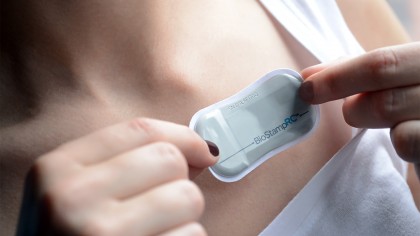Where phone meets body: how people are making themselves into machines
When tech goes from in your hand to in your body
This may be why some big names are keener to talk about implants than spend millions making them a reality. PayPal famously put forward the idea of a 'password you could swallow' in early 2015, as an antidote to the general population's stubborn refusal to adopt anything but the most basic and crackable of passwords.
As part of a presentation titled "Kill all passwords", PayPal developer advocate Jonathan LeBlanc outlined a range of ideas for password alternatives including a chip you'd swallow that would lodge itself inside of you, and a brain implant. And all because your email password is still "1234567890".
This presentation caused a lot of fuss when its details reached the mainstream media, so PayPal had to follow it up with the official statement that the company has "no plans to develop injectable or edible verification systems."
Implants as PR
One big company that has edged a little closer to making bio tech a reality is L'Oreal, a name you likely would never have associated with bioimplanting. In early 2016 at the CES tech show it revealed a temporary skin patch that lets you know the UV level of your surroundings.
Such technology fits a company like L'Oreal well, butis as much of a 'brand cool' exercise as the Lexus hoverboard. It paints a much more accessible view of embedded chips on/in ourselves than the Grinder community offers.

The L'Oreal sensor looks just like a sticker, but houses circuitry that communicates with UV sensors on its surface. It will then relay the data your phone using NFC, (the smartphone connectiong being a running theme in implants and wearable tech). The idea is you'll know when you need to apply sun screen/suntan lotion.
The patch isn't made by L'Oreal though. It was devised by MC10, a healthcare tech company. We'll hand it to L'Oreal, though: its plan to release the UV sticker in 16 countries in 2016 is more than we expect from a campaign designed to make a bit of techy cred rub off on the L'Oreal brand.
Get daily insight, inspiration and deals in your inbox
Sign up for breaking news, reviews, opinion, top tech deals, and more.
Getting Medical
We'll find some more dynamic tech at the source. The L'Oreal sticker appears to be a tangent of MC10's BioStamp, "a body-worn sensor so flexible and soft that it naturally conforms to the contours of the human body."
This is currently in development and, like most body-augmenting tech without dystopian overtones, is of most interest to medical professionals. The BioStamp features an accelerometer and gyroscope plus electrical sensors designed to monitor muscle activity (including the heart).
MC10 says the patch will provide meaningful data at a whole range of points on the body, from joints and limb muscles to the stomach and chest. Its most catchy use is in pinpointing sinus arrhythmia causes. As a predominantly medical device, it's not something you'll buy on the high street, though.

Speaking as someone who forked out for an expensive MRI scan for a knee problem that was ultimately 'fixed' through simple physiotherapy, it sounds potentially a lot more useful than dumping a load of fitness tracker data on your GP to me.
Utter tat
Temporary - or at least surface-level - 'implants' could well be a way to soften the public to the idea of more invasive implants.
One of the forerunners here is the Tech Tat, revealed in late 2015. It's an interesting project, but before delving into what it's for, we need to give you a little context. It's designed by Chaotic Moon Studios, a digital design agency that doesn't appear to have the expertise to actually make the thing. It's not a tech company, it helps brands with their marketing.
"How to design for sh*t that doesn't exist yet-- Our people know how to panel," read a recent Chaotic Moon tweet during SWSX. You get the idea.
The Tech Tat concept itself is solid enough to act as an indicator of future potential, though. Chaotic Moon Studios calls it "our exploration into the use of skin-mounted components and conductive paint to create circuitry that lives on the human body."
It's ultimately similar to the MC10 BioStamp, but has a more eye-catching (if much less practical) transparent design that lets you see its inner workings. Chaotic Moon Studios's original vision is a rather confused effort - parts of demo video showing a circuit powered by AA batteries, others by a CR2032 (or similar) watch battery pressed against the skin, while a total mock-up appears to show a working LED-equipped circuit with no power supply at all.
Forgetting the tech flimsiness for a minute, it's a little different from most cutaneous implants. As well as monitoring your vital signs, it acts as a way to unlock your banking details within the Tech Tat app. It's effectively a password.
This is another example of implant/wearable tech being used to garner attention, while the less media-savvy medical technology companies doing work behind the scenes earn little of the spotlight.
Temporary implants
Less of an 'implant' and more of a technological upgrade, one example of a temporary biohack is the CorTemp Sensor by HQInc. It's a little pill you swallow and it transmits temperature data wirelessly to a recorder device as it passes through your system. And, yes, you'll eventually crap it out.
Unlike a lot of the implant we've talked about, this isn't really a natural extension of what we're getting right now with phones and wearables - it's far more niche. HQInc suggests a whole host of uses, from athletes and the military using it to monitor core body temperature, to doctors using it to check a patient's post-op recovery.
HQInc's Lee Carbonelli explained: "Sensor innovations can be used as diagnostic tools, as well as in wellness and prevention, and apps will play a prominent role in data recording and for transmission of data to medical professionals."
"The sensor passes through the body at the subject's normal rate of motility which can vary anywhere from 24-36 hours," says HQInc.
"Once ingested, the crystal sensor vibrates at a frequency relative to the body's internal temperature, produces a magnetic flux and transmits a low-frequency signal harmlessly through the body." Delightful.
Thankfully, the US's FDA has sensibly only passed the CorTemp for a single use.
Much like the IoT world, implants and body augmenting tech is a murky mix of companies overselling what they're doing and those that aren't really selling it at all. Not to the public, anyway.
The Grinder community comes up with the boldest implants out there, but they are about as far from mainstream acceptance as is possible.
For the foreseeable future, the closest most of us are likely to get to an implant is a grain of rice size sensor eerily similar to the chip you might implant have once had injected into a pet. Perhaps there's something a little reassuring about that.
Andrew is a freelance journalist and has been writing and editing for some of the UK's top tech and lifestyle publications including TrustedReviews, Stuff, T3, TechRadar, Lifehacker and others.
